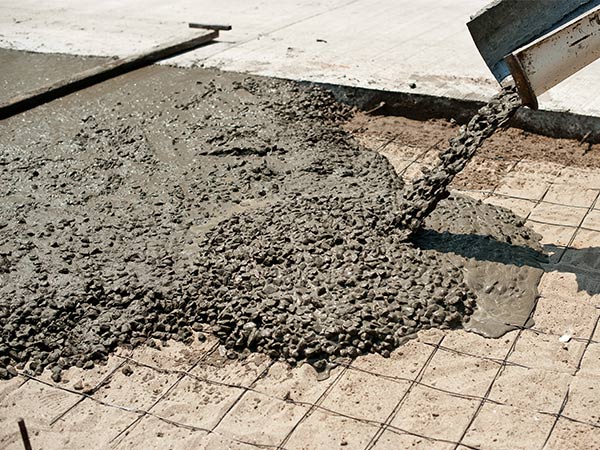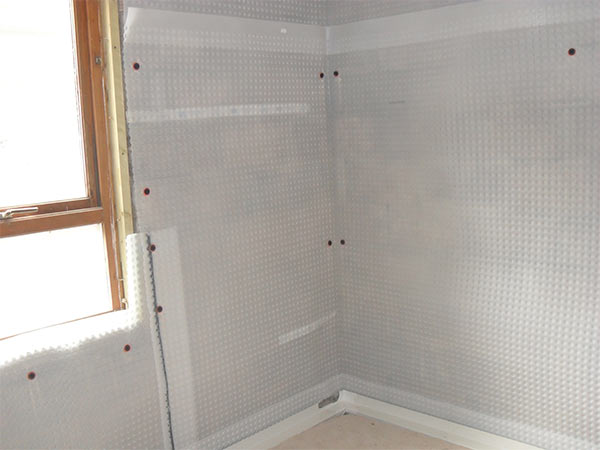Waterproofing Types Explained

At Richardson & Starling we can help you to completely waterproof your property. The three types of below ground waterproofing types as defined by the British standard BS 8102:2009 are:
- Type A – Barrier Protection – This is used when the property has no primary protection against water and depends on a casing to be introduced internally or externally to stop the entrance of water into the inner building material.
- Type B – Integral Protection – The building itself is constructed to resist the penetration of water from the ground. An example of this is water resistant concrete.
- Type C – Drained Protection – It is understood that water could enter the building and an internal cavity is created to depressurise and manage the water out of the building.
Where do you Waterproof?
You will be aware that water can penetrate property above and below ground level and we have noted below some places that may require waterproofing:
- New build basements
- Basement refurbishment
- Semi basements
- Storage or plant rooms
- Car parks
- Soil Retaining walls
- Swimming pools
- Lift pits
- Service ducts
- Podium decks
Waterproofing Type A – Barrier Membranes
Type A waterproofing systems are barrier membranes or waterproof coats such as bitumen which are applied directly to the building structure. The membrane can be applied inside or outside the building to prevent fee water entering the building. Examples of barrier membranes applied to the positive side of the building, (the outside of a building is known as the “positive” side and the inside is known as the “negative” side) are bonded sheet membrane, sodium bentonite matting and liquid applied coatings (cementitious/bitumen or polymer). On the negative side of the building, in the lower section beneath the ground, similar approaches can be adopted to hold water back. Examples of these are cementitious coatings and bitumen or polymer-based liquids applied via spray, trowel, brush or roller.

The water tightness of the Type-A system depends on the effectiveness of the waterproof system, including the preparation and application. It also depends on the structure itself. With a high-water table, which increases the water pressure on the building, pushing through any faults in the waterproofing barrier or poor existing structure may lead to the failure of the waterproofing system and water affecting the basement.
Type B Waterproofing – Integral Protection
Type B (structurally integral) protection as defined by BS8102:2009 (Code of practice for protection of below ground structures against water from the ground) where the structure itself is constructed as an integral water-resistant shell.
What you should take into consideration when installing Type B waterproof systems: They are consistently built of reinforced concrete; the basement structure must be designed within certain strict parameters to ensure it is water resistant.
The water tightness of the Type B construction is dependent upon the quality of the construction and any defects in the concrete can allow water into the building.
The most common defects are:
- permeable concrete
- honeycombing through lack of compaction
- cracks due to thermal expansion and shrinkage
- poor and inadequate placement of water bars
Construction joints are of importance as they are at most risk and commonly associated with leaks. For this reason, it is important that close attention is given when positioning the construction joints and positioning the water stops. Similarly, great care should be taken when laying the concrete and packing it.
Type C Waterproofing: Drained Protection (Water Management Systems)
Type C Protection offers a waterproofing solution by allowing groundwater to penetrate through the external wall or floor as far as the cavity between the external shell and internal cavity drainage membrane. The water is collected via the Cavity Drain Membrane and then diverting into controlled drainage and a designated safe point of disposal.
Cavity Drain Membranes are studded on the external facing surface, allowing any water that penetrates the structure and reaches the membrane to flow into the designed drainage channels that carry the water to either a sump and pump chamber or away from the structure if passive drainage is possible.
Type C systems do not try and hold the water back and therefore there is no pressure put on the waterproof system. The system is able to deal with changes in the ground water conditions.
Type C Waterproofing Systems – Maintenance
Type C systems need to be checked and serviced once per year at the very minimum. It may be the case that it needs serviced more than once in a year, depending on the circumstances. The frequency and the nature of service visits will depend on factors including site condition, materials, machinery used and the consequences of any system failure.
Waterproofing or Damp Proofing?
Our teams at Richardson & Starling are often asked to explain the difference between waterproofing and damp proofing. At Richardson & Starling we have many years in the property care sector, therefore, you can trust our business to find the solution that is going to be more suitable for your property.
We will consider the external ground levels before we start with any work. This means that we will visit your property to survey it. We will be able to tell how we can solve the issue by investigating the problem. Penetrating damp from the ground may require a waterproofing system and if the damp proof course is not effective then your property may need some remedial damp proofing work.
Your Local Basement Waterproofing Specialists
Find more information about property waterproofing in other sections of our website. At Richardson and Starling, we take a varied approach to keeping spaces below the external ground level dry.
We travel across Scotland and the North of England installing traditional cellar tanking methods and using modern water management techniques that include; cavity wall and floor membrane, specialist drainage channels and removal of water using sumps and pumps.
As you can see from our customer testimonials, our customers have been delighted with the work that we have done for them in the past. Experience and qualifications matter when it comes to property waterproofing, that is why our surveyors are qualified to CSSW (Certified Surveyor in Structural Waterproofing), surveyors that can create a waterproofing solution for any property.
If you are ready to get started with your property waterproofing project, then call us today to book your property survey.Not sue what type of waterproofing should be appied to your property? Contact your local branch for advice or a property survey today!
